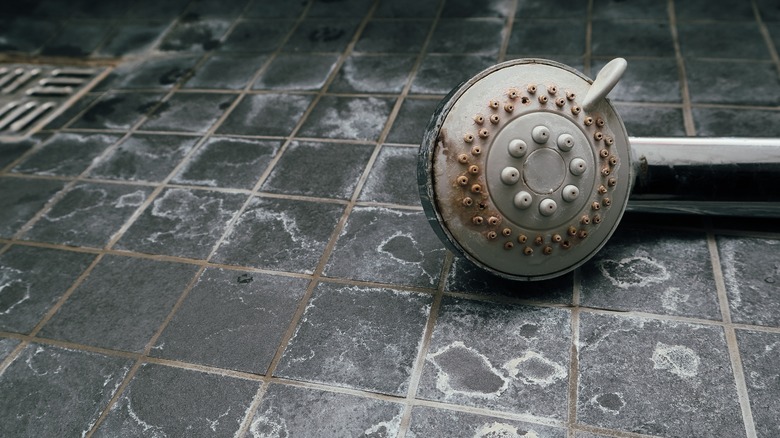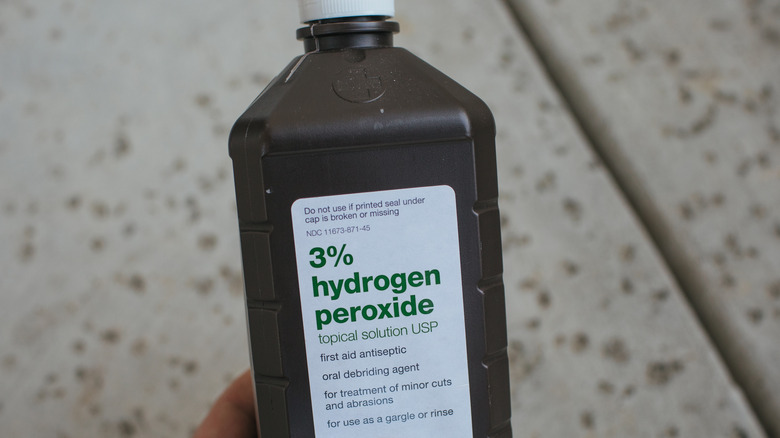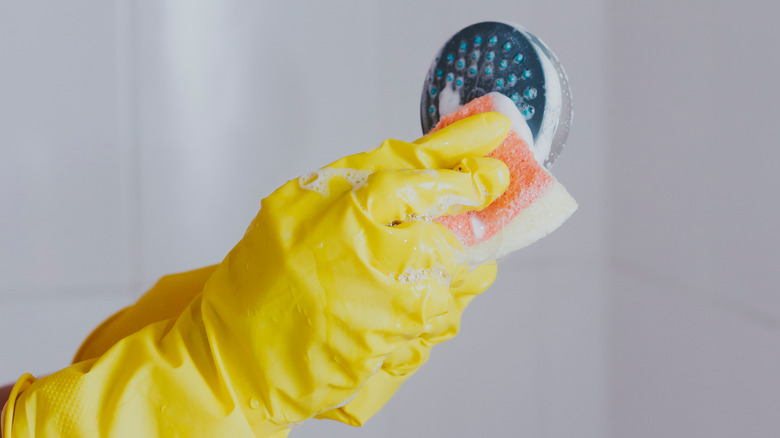Can You Use Hydrogen Peroxide To Clean A Shower Head?
You may have a routine down pat for cleaning your shower walls, doors, and perhaps even the drain. Yet, have you thought about the importance of cleaning the shower head? Though it may seem like only clean water comes through them (so how can it really get that bad?), the reality is cleaning your shower head is essential. That's due to the buildup of bacteria, mildew, and mold that can occur within each of those tiny holes. There's no simple way to see what's lurking there, but using a holistic cleaning agent like hydrogen peroxide can be highly effective.
Most shower heads are rather straightforward systems in which the water comes into the pipes and through the shower head hose before being disbursed to numerous tiny holes that allow you to have ample water spraying on you as you bathe. Each one of those areas, though, can be a hiding space for bacteria and mold growth. This, coupled with the warm temperatures in the bathroom, allows these organisms to spread quickly.
There are multiple ways to clean a shower head, but the goals tend to be the same. You need to remove these organisms, flush away any hard water mineral deposits that could also form here, and ensure you're not damaging the shower head itself. Most of the time, you can avoid replacing it if you clean your shower head often enough. Also, while many chemical-based cleaning agents exist, hydrogen peroxide may be a safer option for some homes.
Why hydrogen peroxide works well on a shower head
Hydrogen peroxide is a type of liquid that reacts to oxygen exposure. When hydrogen peroxide comes into contact with organic material, like the material lurking in your shower head, spontaneous oxidation occurs. When that happens, it can loosen the adhesion of that material from the shower head, allowing water to rinse it away.
A closer look at how hydrogen peroxide works comes down to its chemical structure. It's made of two hydrogen atoms along with two oxygen atoms. When any organic material comes in contact with it, like mold, mildew, or bacteria, the hydrogen peroxide begins to break down, which you'll notice as fizzing or foaming. This is why it has been used as a reliable antiseptic on skin and open wounds for decades. It kills the bacteria present quickly without damaging the surface.
While it works so well to break down organic matter, it's not going to cause any damage to the steel or plastic hose from your shower head. It works just as well, if not better, than any type of bleaching agent you use. It doesn't create any soap or other residue on these surfaces either. It may also help with the removal of built-up minerals as well. Even better, it does all of this without introducing any type of chemical to the cleaning process, which means you can keep your home a bit more natural and less toxic.
How to use hydrogen peroxide on your shower head
A good question is this, though. How do you get the power to oxidize hydrogen peroxide into all of those holes to clean the shower head? There's no wrong way to do it, and you can use hydrogen peroxide on most surfaces in the shower as well. One option is to remove the shower head and place it in a bit of water to allow it to soak. Then, pour hydrogen peroxide over the top of the shower head so it enters the small openings. This should create a fizzling effect as the liquid goes to work. You can also spray hydrogen peroxide into those openings and allow it to go to work for you. Let it sit for a few minutes before rinsing it away. There's no need to dilute the hydrogen peroxide but be sure there's good ventilation present.
Another option is to fill a plastic bag with hydrogen peroxide and fit it over the top of the shower head, securing it into place with a rubber band or other tie. You'll need to be sure enough liquid is present to cover the actual shower head. This method can be done a bit easier by just soaking the removable portion of the shower head in a bucket. If there is hard-water buildup on the shower head, use a soft bristle brush on it to loosen it enough after the hydrogen peroxide has time to work. Then, rinse.


